Features of Growing cannabis in Thailand

- 1. Legal aspects
- 2. Features of growing cannabis in thailand
- 3. Climate regions in thailand
- 4. Types of grow spaces
- 4. a. Greenhouses
- 4. b. Outdoors
- 4. c. Indoors
- 4. d. In summary
- 5. Post-harvest processes
- 5. a. Drying process
- 5. b. Curing process
In 2018, Thailand became the first Asian country to legalize medical cannabis and since 2022, the Thai Food and Drug Administration officially legalized the possession, cultivation, distribution, consumption, and sale of cannabis. This makes it possible for Thai citizens to grow feminized seeds at home. So why smoke store-bought flowers when you can have an unlimited supply of top-shelf buds for cheap?
For those who want to adventure into the world of cannabis growing, make sure to read about all of the features of growing weed from germination to harvest in Thailand.
Legal Aspects
As mentioned above, Thailand (aka the Land of Smiles) became the first Asian country to legalize medicinal consumption back in 2018, and most recently, in 2022, fully legalize cannabis. This means that it is legal for Thai citizens to:
- consume cannabis in private areas;
- for doctors to prescribe medical cannabis;
- to buy cannabis in licensed shops;
- to grow cannabis at home for personal consumption.
Weed dispensaries were available as early as April 2022, which meant that Thais could walk into a store and buy weed legally, but also meant that anyone in Thailand could grow their own weed for personal consumption. And as a matter of fact, there are currently no restrictions on how many plants one can grow at a time, although that could change soon. It’s much cheaper to grow than buy and you have a 100% guarantee of the quality. All it takes is a little bit of reading and learning, so let’s get into it.
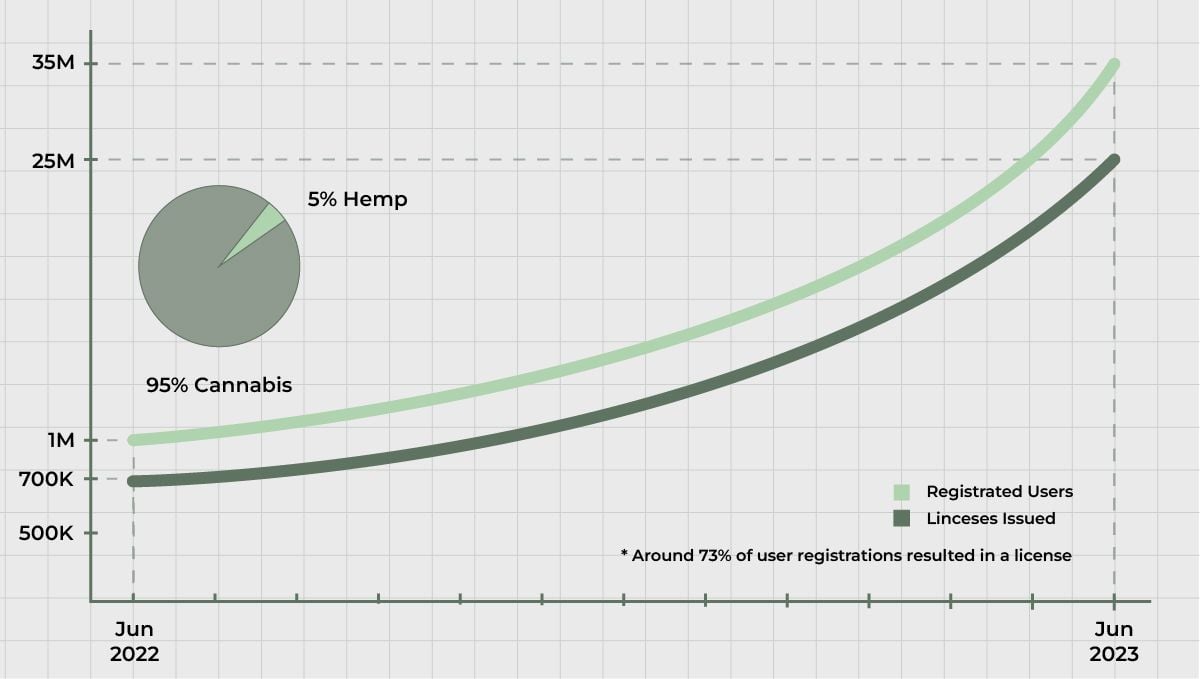
Features of Growing Cannabis in Thailand
Thailand is one of the most biodiverse countries in the world, known for its lush, tropical climate and healthy, fertile soil which are an indication of how good the Thai climate and soil are for cannabis growing. The country’s tropical climate, characterized by high temperature and abundant rainfall provides optimal conditions for outdoor growers, this means that yes, you can grow outdoors and have excellent results but despite the ideal conditions, there are challenges that growers may face, especially the high humidity levels during the rainy season which most often lead to mold. Because of this, there are several things to keep in mind before you opt for growing indoors, outdoors, or in greenhouses.
Climate Regions in Thailand
There are a couple of things to consider before making the choice of where to grow (indoors vs outdoors vs greenhouses). Among the most important things is establishing the conditions we’re dealing with as you may have to invest a little, a lot, or not invest any money at all (because the conditions will vary from one place to the other).
Thailand has 6 meteorological regions, with slightly different climate conditions, they are- Northern, Northeastern, Central, Eastern, Southern (East Coast), and Southern (West Coast). Now, they're not exactly the same as their temperature and humidity vary slightly but they’re all characterized by high temperatures and high humidities as you can see in the table below which shows the averages in Thailand:
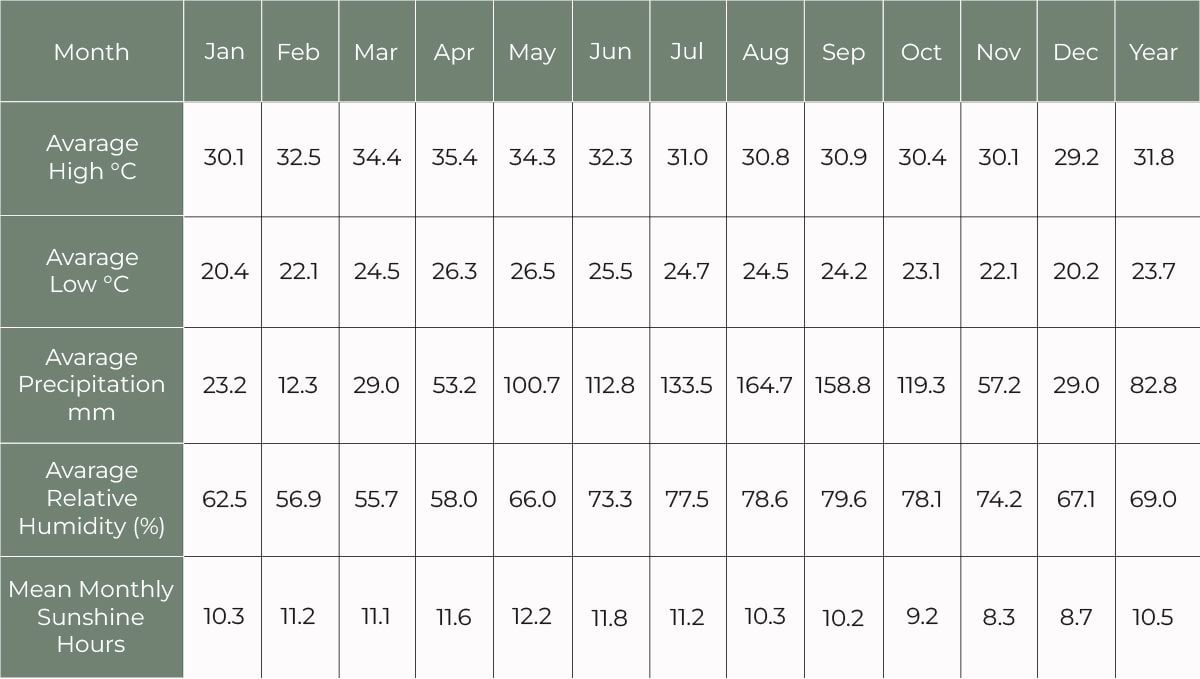
As you can see, the climate in Thailand is very hot and humid (aka Tropical). Now that we know what we’re dealing with, it's time to compare them to what the actual goal is when talking about growing cannabis. The perfect conditions for cannabis are the ones shown in the table below. Keep in mind that these are ideal conditions that commercial growers aim for. Generally speaking, home growers have a wider range of what is considered optimal growing conditions.
Home growers will have good results as long as the temperatures stay within 15 - 25°C and the relative humidity levels range between 40 - 70%, but the wider range requires you to keep an eye out for, for example, hotter days or extra humid days and take proper measures if needed. This basically means that your decision on whether to grow indoors, outdoors, or in a greenhouse will depend on your local climate conditions and how far you’re willing to go in order to get close to the ideal ones.
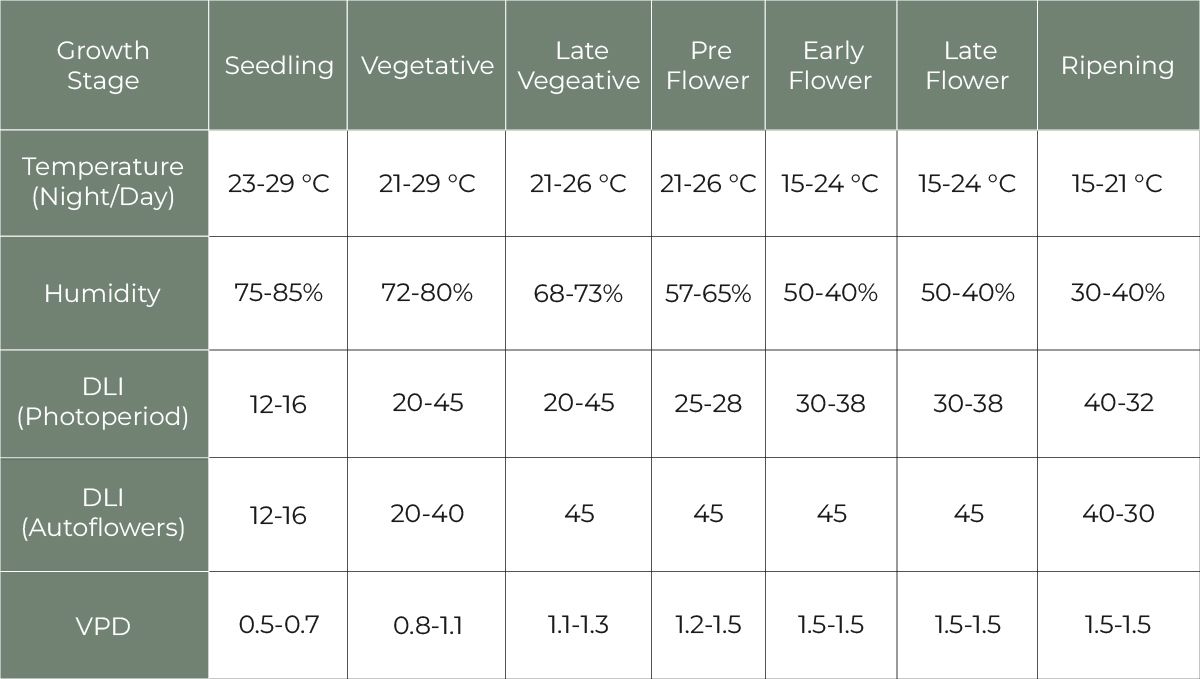
Knowing what the local climate and knowing your goals allows you to better choose where to grow our cannabis crop. But Before going into more detail about the advantages and challenges of the different types of grow spaces, let’s talk about genetics or cannabis strains which is probably the most important thing when growing cannabis and should be chosen according to the climate conditions you're dealing with.
Genetics
Starting with the best genetics possible is a must. This is very simple to explain: you can provide perfect conditions to bad-quality seeds and they will still not perform because they do not have the genetic potential in them.
When talking about growing cannabis in Thailand, autoflowering and fastflowering strains are the perfect choice. Not only they will finish faster but opting for Sativa-dominant hybrids gives you a huge advantage because it reduces the risk of mold and other issues as they have developed in Tropical climates, acquiring characteristics such as larger internodal spacing and thinner leaves that make them more resilient against hot, humid Thai weather.
It doesn’t matter if you’re growing indoors, outdoors, or in greenhouses, starting with the best seeds possible ensures that you’re not wasting money, time, and effort as they have the genetic potential required to develop to their maximum and make the most out of your conditions, regardless of where and how you’re growing.
Types of Grow Spaces
Greenhouses
Greenhouses offer a unique combination of the benefits of both indoor and outdoor growing environments. They are particularly suited to cannabis cultivation in Thailand due to the country's tropical climate. Thai climate is perfect for plants in the vegetative stage but the high humidity can cause issues, like mold, further into the flowering stage. Growers can prevent this with proper airflow (a big enough oscillating fan) that will help with air movement and help keep the humidity in check.
Advantages of Greenhouses for Growing Weed in Thailand
- Certain Degree of Control: One of the most significant advantages of greenhouses is their ability to control environmental conditions to a certain degree. While growers still rely on the local climate, they can manage temperature, humidity, and light exposure to create optimal conditions for cannabis growth. This level of control helps mitigate challenges faced when growing cannabis outdoors in Thailand, such as high humidity and when you need to increase or decrease the light cycle.
- Protection from Pests and Diseases: Greenhouses provide a physical barrier against pests and diseases, reducing the need for chemical pesticides. This benefit is particularly important in Thailand, where the warm climate often leads to a high prevalence of pests such as caterpillars. Furthermore, the controlled environment in a greenhouse helps prevent the spread of diseases like powdery mildew and botrytis, which are common in high-humidity environments.
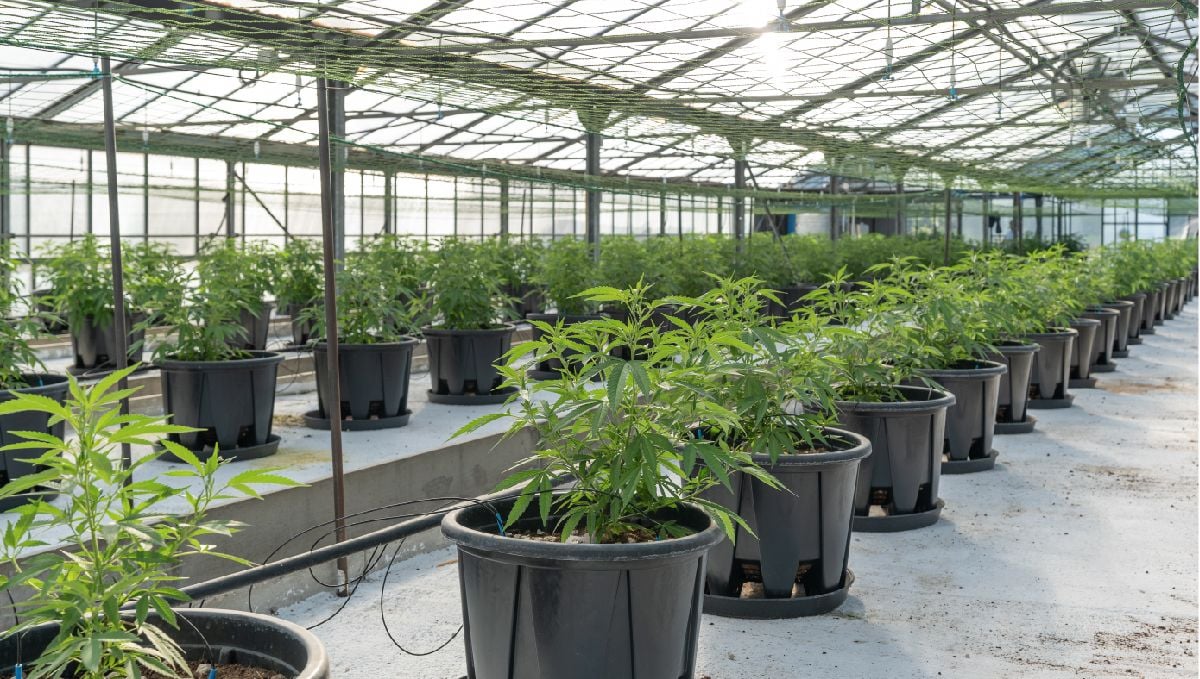
- Year-Round Cultivation: Thailand's tropical climate presents challenges for outdoor cannabis cultivation, such as during the rainy season. However, with a greenhouse, growers can protect plants from excessive heat and storms which can cause overwatering, allowing them to cultivate cannabis year-round, regardless of external weather conditions. This feature maximizes productivity and makes cultivation more predictable.
- Efficient Use of Resources: Greenhouses make efficient use of resources by harnessing natural sunlight, reducing the need for artificial lighting and resulting in energy cost savings. Additionally, they allow for the implementation of efficient watering systems, such as drip irrigation, which reduces water usage.
- Scalability: Greenhouses offer the advantage of scalability. As demand grows, farmers can easily add more greenhouses to increase production capacity without having to modify or adjust the existing operation.
Challenges of Growing Weed in Greenhouses in Thailand
- Climate Control: Greenhouses allow for climate control, but only to a certain degree. Maintaining the optimal climate within a greenhouse can be challenging, especially in Thailand's tropical climate. Without proper ventilation, greenhouses can become excessively hot and humid, leading to issues such as heat stress, mold, and mildew. Investing in adequate ventilation, dehumidification, and temperature control systems is crucial.
- Pest and Disease Management: While greenhouses provide a physical barrier against pests, they can also create an environment that is conducive to pest and disease outbreaks if not properly managed. Once pests or diseases are introduced, they can quickly spread within the closed environment. Regular monitoring and implementation of integrated pest management practices are essential for prevention and effective management.
- Energy Costs: Although greenhouses can take advantage of natural sunlight, they often require supplemental lighting, especially during the rainy season or when extending light cycles. This can lead to high operating costs due to increased energy consumption.
- Initial Investment: The initial investment required to set up a greenhouse with proper environmental control systems can be expensive. Infrastructure, equipment, and technology costs can act as significant barriers for some growers.
- Knowledge: Successful greenhouse cultivation demands a high level of technical knowledge and skill. Understanding how to manage the greenhouse environment and care for cannabis plants within this specific context can be complex and requires continuous learning and adaptation.
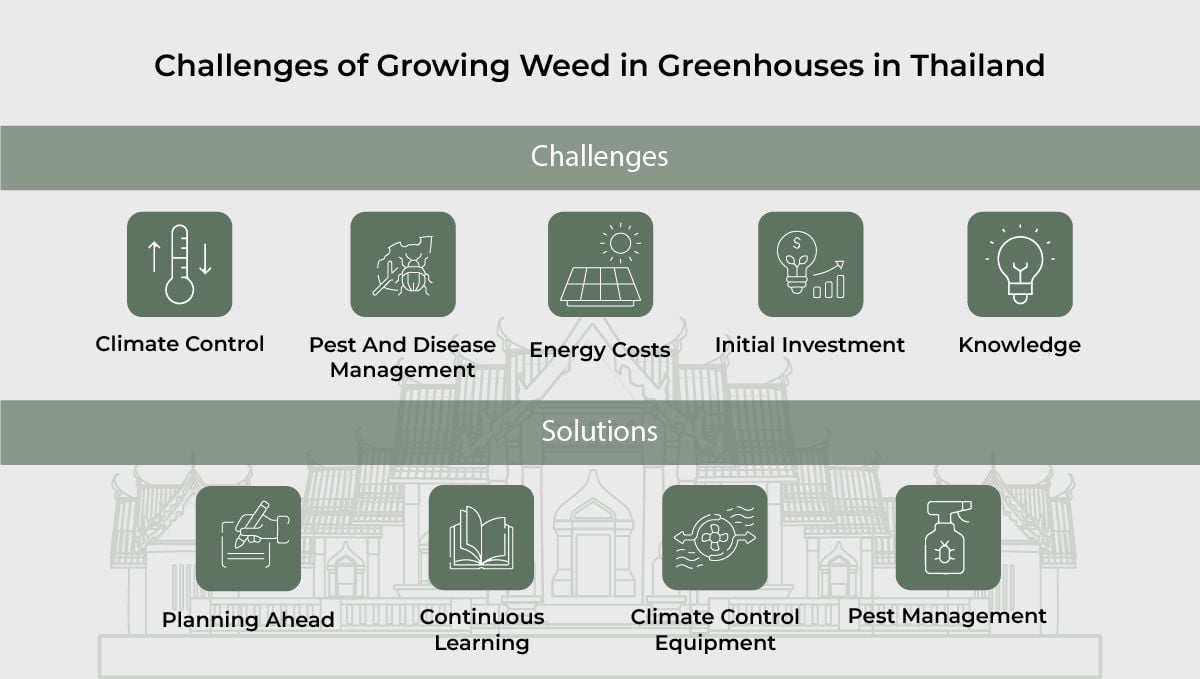
How to Overcome the Challenges?
Cultivating cannabis in greenhouses in Thailand presents unique challenges. However, with careful planning and a commitment to continuous learning, growers can effectively overcome these obstacles. The primary goal when growing cannabis is to provide the ideal conditions for healthy plant growth. So if needed, invest in proper climate control equipment and utilize sensors to monitor and adjust growing conditions.
In addition, implementing a proper integrated pest management routine is essential, especially in Thailand. Regularly inspect your plants for pests and insects, and consider incorporating weekly or bi-weekly pesticide applications into your feeding schedule to help prevent infestations and diseases.
Outdoors
Growing outdoors is the complete opposite of growing indoors because your plants are directly exposed to outdoor conditions. Thai growers are blessed with an excellent climate for cannabis so there’s no need to worry about cold or snow, such as in regions with well-defined seasons where it’s almost impossible to grow during winter, for example, where temperatures can be lower than 10 °C.
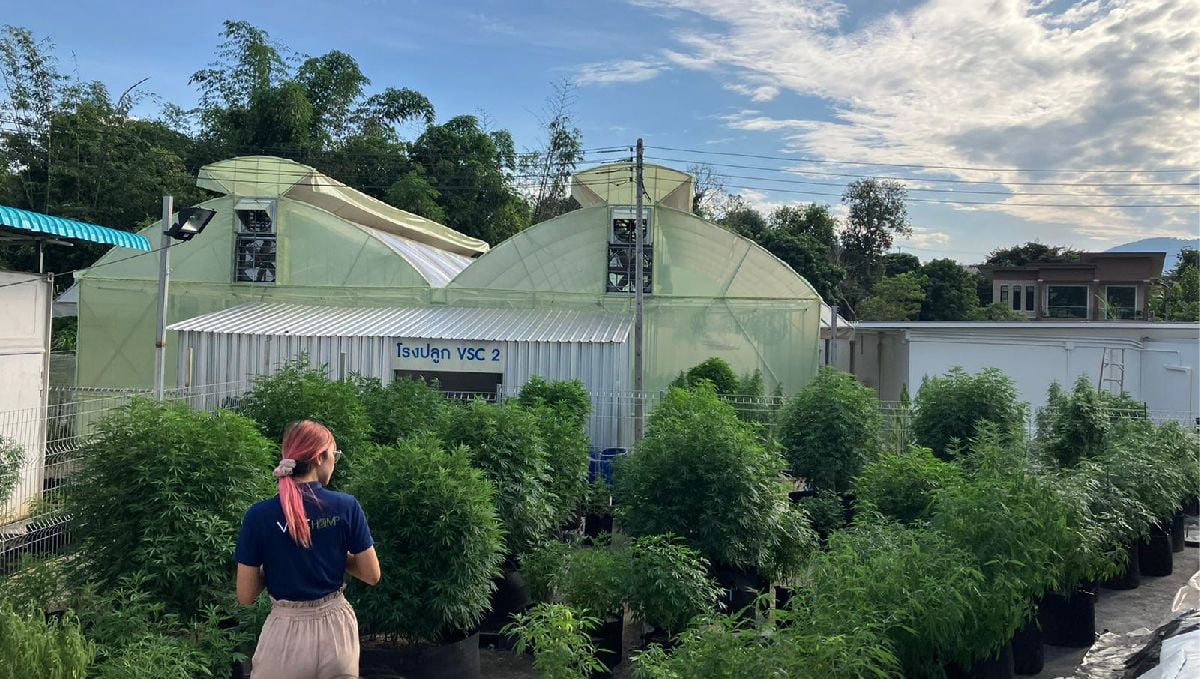
Thai climate is perfectly suited for the vegetative stage when growing outdoors. Now, when talking about the flowering stage, it's essential to keep an eye out for mold during the rainy season, especially with strains that grow big, dense flowers.
Advantages of Growing Weed Outdoors in Thailand
- Low Initial Cost: Growing cannabis outdoors is significantly cheaper compared to indoor or greenhouse cultivation because nature provides almost everything your plants need to grow. This eliminates the need for costly growing equipment, resulting in a drastic reduction in the overall cost of the grow operation.
- Climate: Cannabis plants thrive in warm and tropical climates, making Thailand an ideal location for outdoor cultivation. However, the abundant rainfall can also lead to overwatering which oftentimes leads to mold issues. It is important to note that certain cannabis strains may be more suitable for specific regions within Thailand, as climatic conditions can vary slightly across the country.
- Sunlight and Light Cycle: Cannabis plants require an ample spectrum to grow and produce high-quality buds. Keep in mind that photoperiod plants require an 18/6 light cycle for the vegetative stage and a 12/12 light cycle for the flowering stage.
Thailand's proximity to the equator ensures a relatively consistent duration of sunlight throughout the year, with approximately 12 hours of sunlight per day. This is not ideal for photoperiods because they need 18/6 (light/dark) light schedule for vegetative stage, and 12/12 to start flowering. Yet, it is not a big deal for autoflowering cannabis strains because their lifecycle doesn't depend on the light schedule.
Challenges of Growing Weed Outdoors in Thailand
- Climate Variability: While Thailand's tropical climate is generally favorable for cannabis cultivation, there can be variations in weather patterns across different regions of the country. Excessive rainfall, storms, or unexpected weather changes can impact plant health and growth. It is crucial to monitor weather conditions and take appropriate measures to protect plants from extreme weather events which can cause overwatering. This leads to the next point:
- High Humidity and Mold: Thailand's high humidity levels can create a conducive environment for mold and fungal diseases, such as powdery mildew and bud rot. These issues can have a negative impact on plant health and reduce yields. Ensuring adequate airflow, maintaining proper spacing between plants, and implementing preventive measures, such as using organic fungicides, can help mitigate these challenges. Additionally, Thailand is home to various pests and diseases that can pose a threat to cannabis plants. Common pests include aphids, spider mites, caterpillars, and thrips. It is important to regularly inspect plants for signs of pest infestation and disease and take prompt action when necessary. Implementing integrated pest management strategies and utilizing organic pest control methods can be effective in managing these issues.
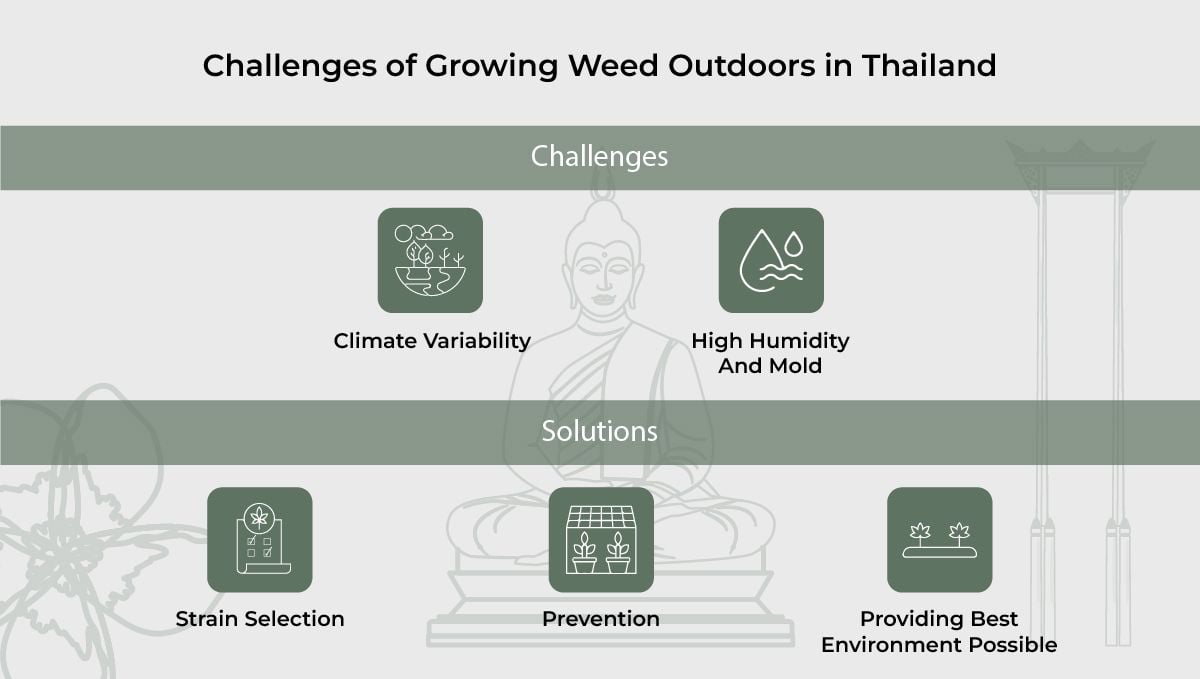
How to Overcome the Challenges?
- Strain Selection: When cultivating cannabis in Thailand, it is important to choose strains that are well-suited for the local climate and growing conditions. Look for strains known to perform well in tropical environments, such as sativa-dominant hybrids. Autoflowering strains, in particular, exhibit resilience to harsh climates due to their genetic makeup. Remember to source seeds from reputable vendors to minimize potential issues throughout the grow cycle.
- Prevention: While Thailand's climate generally favors cannabis cultivation, it is essential to prepare for variations in weather patterns and the possibility of extreme weather events. Implement strategies to protect plants from heavy rainfall, storms, or temperature fluctuations. This may involve using temporary shelters, shade cloth, greenhouse-like structures, or cultivating in pots which allows you to move plants around and shield them during adverse weather conditions, and prevent rodents or insects from eating your plants' roots.
- Providing the Best Environment Possible: When growing outdoors, aim to create optimal growing conditions. Properly spacing the plants and trimming lower foliage can enhance air circulation and help prevent pest infestations and mold issues. Implementing integrated pest management (IPM) practices, including regular inspections, organic pest control methods, and the use of beneficial insects such as ladybugs and praying mantis, will aid in preventing major pest infestations.
Indoors
Indoors refers to growing weed in an enclosed space that could be a room, grow tent, or designated area where you’re basically mimicking nature. Growing indoors in Thailand will require an AC unit and a dehumidifier. The good news is, once you buy this equipment they’ll do the work for you and you can rest assured your plants will be happy all year long.
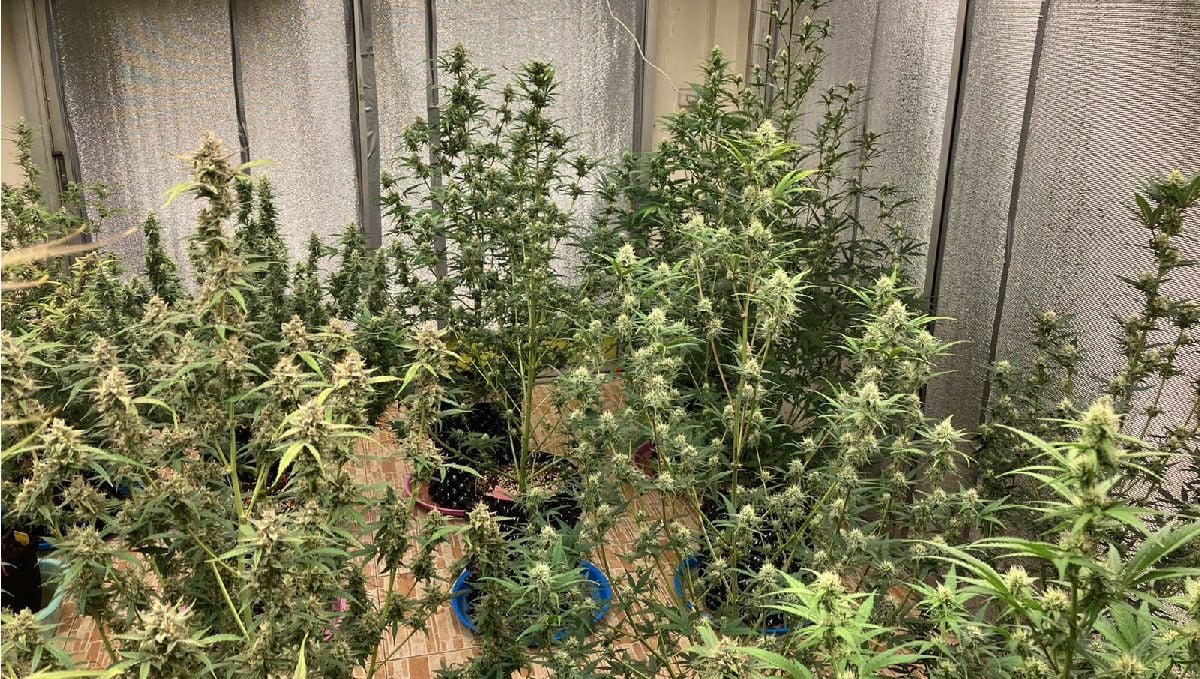
This may seem difficult but it’s actually not, and once you properly set up your grow operation and equipment, you’ll always get consistent quality as you don’t have to adjust your style or setup to the weather outside or any other external factor.
Advantages of Growing Weed Indoors in Thailand
- Complete Environmental Control: Indoor cultivation provides the advantage of total control over the environment, including temperature, humidity, and lighting. This level of control allows for consistent production of high-quality cannabis and helps mitigate issues related to Thailand's high humidity and varying light conditions.
- Year-Round Cultivation: Unlike outdoor growing, indoor plants are not exposed to outdoor conditions. Growers can cultivate cannabis year-round, enabling multiple harvests throughout the year as long as the equipment functions properly. Proper cleaning and maintenance are essential for managing the equipment effectively.
- Pest and Disease Management: Indoor cultivation reduces exposure to pests and diseases commonly found in outdoor environments. By implementing proper sanitation practices and care, such as using filters to shield duct tubing for air circulation, sterilizing equipment, and using gloves the risk of pest infestations and disease outbreaks can be significantly reduced. However, it's important to note that although it reduces exposure, once an infestation sets in, it can be challenging to completely eradicate.
- Security and Privacy: Indoor grows offer increased security and privacy, as the fact that you are growing cannabis can remain undisclosed unless you choose to share it.
- Top-Shelf Weed: With the ability to control every aspect of the environment, indoor growers have an advantage in producing top-quality cannabis without facing the challenges that greenhouse and outdoor growers may encounter.
Challenges of Growing Weed Indoors in Thailand
- Initial and Operational Costs: Setting up an indoor grow room in Thailand can be costly. The initial investment should include grow lights, an air conditioner, and a dehumidifier. Additionally, there are basic necessities such as substrate (coco fiber, soil, or hydroponic medium), nutrients, and seeds, among others. Depending on the size of the grow operation, a backup power supply may also be needed.
It's important to consider not only the cost of the equipment but also the operational expenses, including maintenance costs and the electricity bill. The increasing price of electricity in Thailand can be a significant disadvantage in terms of operational costs.
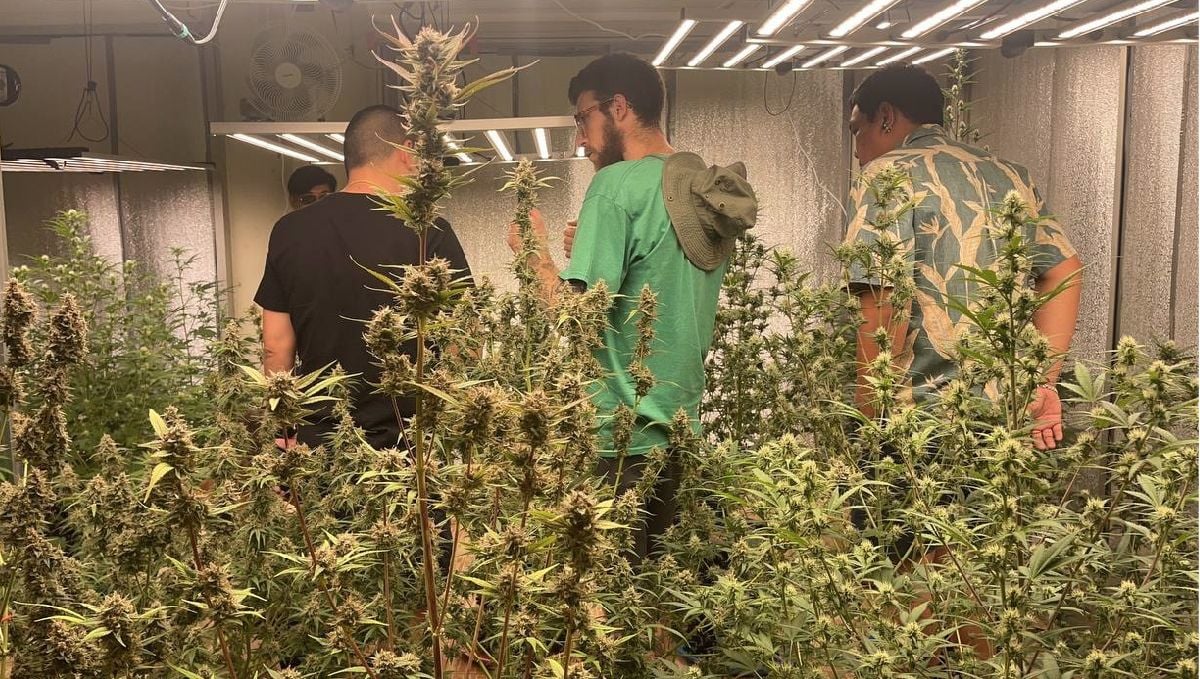
- Space Limitations: Unlike outdoor cultivation, indoor grow spaces are often limited in size. This constraint can restrict the number of plants a grower can cultivate and make it more challenging to set up growing equipment properly.
- Technical Knowledge and Skills: While relatively straightforward to manage, cultivation equipment requires understanding and technical skills to operate the equipment that controls the indoor environment.
How to Overcome the Challenges?
- Planning Ahead: Thorough planning is essential to anticipate costs and allocate your budget wisely. Avoid blind spending by measuring your grow space and consulting with local grow shop suppliers who can provide valuable guidance. For online purchases, review video tutorials and step-by-step guides to ensure a clear understanding of your requirements and avoid unnecessary expenses.
- Energy-Efficient Equipment: Investing in energy-efficient equipment, such as LED lights and energy-saving growing equipment, can help reduce operational costs over time. Implementing automated climate control systems not only reduces the risk of human error and ensures consistent growing conditions but also helps optimize electricity usage, resulting in cost savings.
- Implementing training techniques: Despite the limitations in space, certain growing techniques like SCROG (Screen of Green) and SOG (Sea of Green) can maximize space utilization and increase yields. Additionally, consider growing strains with shorter grow cycles or naturally compact growth habits to make the most of your available grow space.
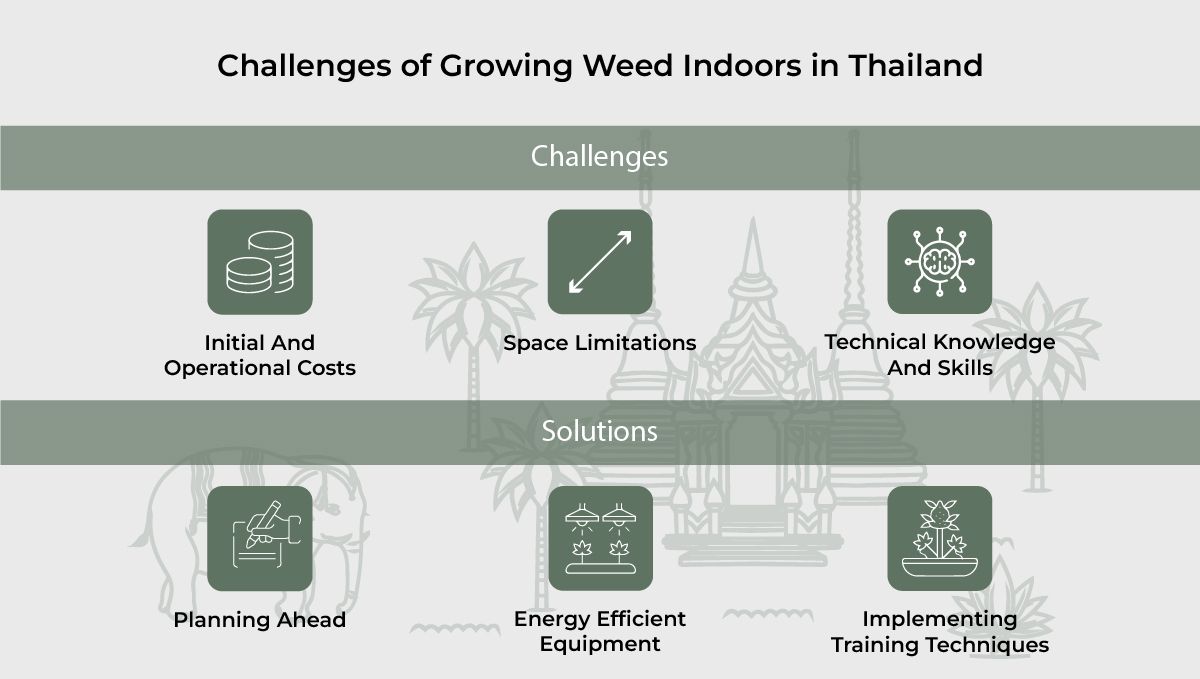
In Summary
Now that you know the advantages and challenges of the different types of cannabis growing, how to choose the best one for you?
- Outdoors: If you want to learn the basics first before investing, opt for outdoor growing as the initial investment is minimal. You don't even need a backyard, you can grow pretty decent bud on your balcony and all you need is a pot, a seed, soil and nutrients.
- Greenhouses: If you are willing to invest a little bit more, greenhouses are great because you are using natural resources (such as sunlight), and do not necessarily have to spend money on equipment unless needed. For example, you won't have to buy an oscillating fan unless the humidity is too high or buy extra lighting unless your plants are not getting enough direct sunlight.
- Indoors: If you don't mind the initial investment and want to get right into it, indoors is the best choice. Yes, the initial investment can be quite high but after you set up everything, you won't deal with any issues as the equipment will ensure your plants get exactly what they need to thrive.
Don't forget that the natural light cycle in Thailand is 12 hours of light and 12 hours of darkness, which means that Fastflowering strains will not grow much as they will flower from seed. So if you're growing outdoors or in greenhouses, always opt for autoflowers as they are able to go through the vegetative stage regardless of the amount of light/darkness. Indoor growers, on the other side, are able to control everything (including the light cycle), which allows them to opt for autoflowers or Fastflowers, or even both!
Post-Harvest Processes
Apart from providing good growing conditions and starting with top-quality genetics, in order to guarantee top-shelf harvests you also have to provide perfect conditions for the drying and curing stages.
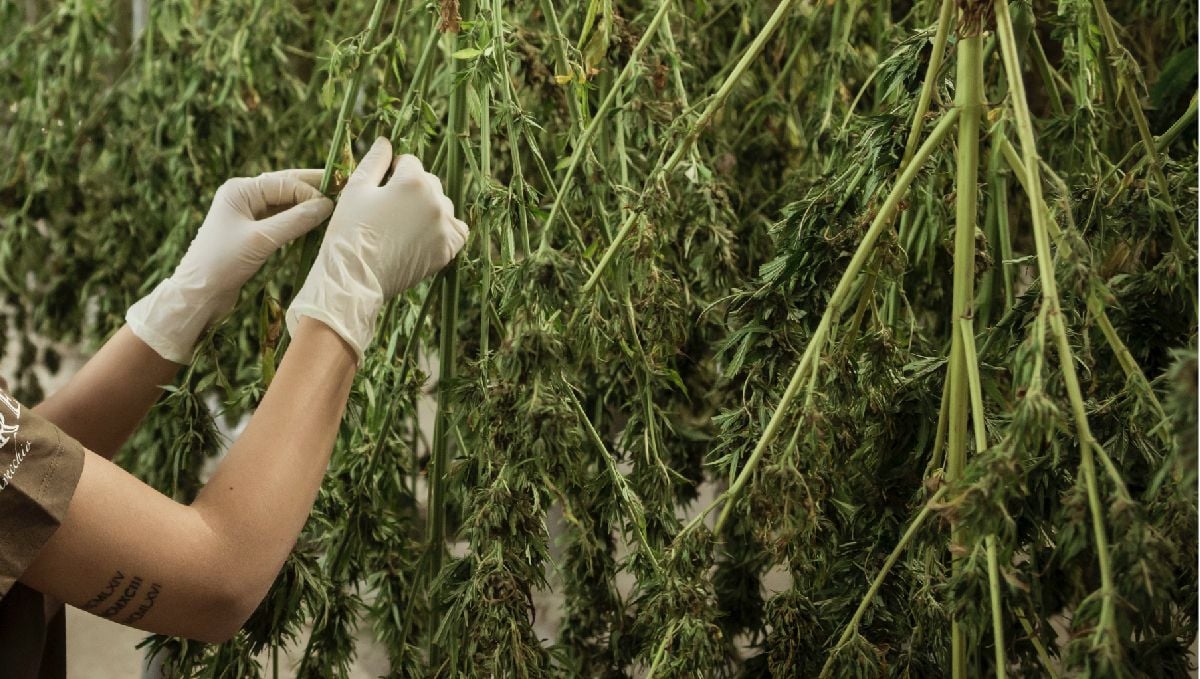
Fail to do them correctly and the buds will taste and smell like hay, wasting all the time, money, and effort spent on growing your plants. This means that in order to bring out and preserve the flowers’ maximum flavor, aroma, and potency, there are at least 4 more weeks to go.
Drying Process
The drying stage consists of slowly reducing the moisture content of the fresh cannabis flower all the way from the 70 - 80% range down to the 10 -12% range. This should be done very slowly to preserve the quality of the buds. Do it too slow and the buds might get mold, do it too fast and the buds will become overdry and taste like hay. This is why you should keep the following conditions when drying cannabis:
- Temperature: 15 °C - 20 °C
- Relative humidity: 58% - 62%
This means that yes, when drying cannabis in Thailand you will need an AC unit and dehumidifier. Cannabis can take anywhere from 7 - 21 days to dry (strain dependent), usually being ready around the 14 -16-day mark. Once the branches snap but don’t break (meaning they’re still attached by the fibers) or when the wood moisture content reads 10 - 12%, the buds are properly dry and ready to start the curing process.
Unless it’s the only option, drying cannabis outdoors is not recommended as there is no way to maintain optimal drying conditions which will cause the cannabinoids and terpenes to degrade, affecting the quality of the harvest.
Curing Process
The curing process consists of placing the buds in a jar in order to not only allow the remaining moisture to spread throughout the whole bud and the chlorophyll to be broken down, but also to guarantee maximum quality as you’re basically maintaining your harvest in perfect storage conditions as to prolong shelf-life for as long as possible.
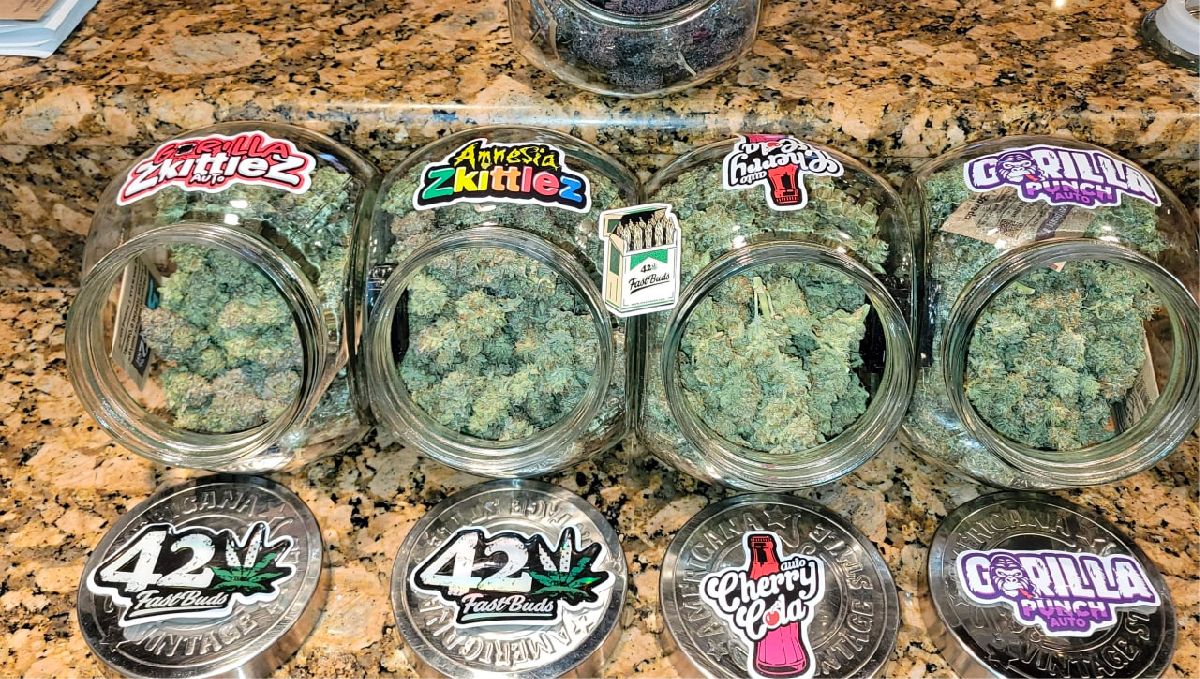
In order to get a perfect cure every single time, the recommended conditions are:
- Temperature: 15 °C - 20 °C
- Relative humidity: 58% - 62%
The best way to maintain these conditions is to place a small digital hygrometer in the curing jars in order to ensure that the jar is at 58% - 62% humidity levels at all times. So keep an eye on them, at least during the first 1-2 weeks of curing and burp them (open the jar for 30-60 min) in order to maintain the perfect curing conditions you’re aiming for.
This is vital for flower quality as if the humidity is too low (below 58 - 62%) the flowers will overdry and there’s no way to put the flavor back after the terpenes have evaporated. And if the humidity is too high (above 58 - 62%) there’s the risk of mold, and you cannot save moldy flowers.
If you cannot find or cannot afford a hygrometer, you can get away with opening the jars (“burp”) once or twice a day. This lets out some of the built-up humidity and allows some fresh air in. After the first week or so, the containers can be opened less frequently (anywhere from once a day to once every other day). And after a couple of weeks of burping, the curing process is complete.
And remember: always keep your curing jars in a dark, cool place, like a cupboard, in order to keep your weed fresh and extend shelf life as much as possible.









Comments